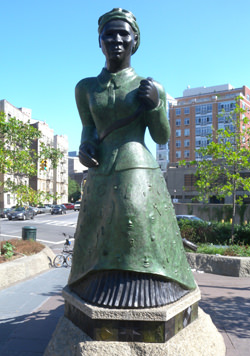
DAVID ADAMS looks at the life of Harriet Tubman, a former slave and Christian who was a key figure in the Underground Railroad in the US during the 19th century…
Soon to be the first African-American to be featured on a US banknote, Harriet Tubman’s Christian faith was instrumental in inspiring her to become the most famous of the “conductors” on the ‘Underground Railroad’ for escaped slaves.
Tubman – then Araminta ’Minty’ Harriet Ross – was born on a plantation in Maryland sometime between 1820 and 1825, one of a big family born to two enslaved parents – Harriet ‘Rit’ Green and Ben Ross.

Harriet Tubman depicted here in a statue in New York City. PICTURE: via Wikipedia
Her childhood was marred by her experiences of slavery – not only was her family split up with three of her sisters sold off to other plantation owners but she and the rest of the family suffered daily physical violence.
In fact, violence which was inflicted on Harriet while still a child was to have life-long consequences for her – not only did she bear the scars of brutal whippings, she also suffered seizures, headaches and narcolepsy after being struck in the head by an object thrown by an overseer at her when she refused to obey him.
While her father Ben was freed from slavery at the age of 45 – due to the provisions of a will of his previous owner – the same instructions were not upheld for the rest of the family and Ben continued working as a foreman for his former owners.
In 1844, Harriet (who adopted the name Harriet over Araminta) married a free black man named John Tubman.
Five years later in 1849, following the death of her owner and having suffered sickness which led her to worry for her future (a sickly slave was considered of low value), Harriet Tubman escaped with two of her brothers, Harry and Ben (her husband had refused to go with her). Her brothers subsequently returned to the plantation but Harriet, seeing them safely back home, set off alone for Philadelphia.
To do so, she made use of the covert network of abolitionists known as the Underground Railroad – an “organisation” she would go on to be a key figure in.
She recalls her emotion at crossing into the slave free state of Pennsylvania: “When I found I had crossed that line, I looked at my hands to see if I was the same person. There was such a glory over everything; the sun came like gold through the trees, and over the fields, and I felt like I was in Heaven.”
Rather than remaining in safety in America’s north after her arrival, however, Tubman decided to return to the South and help others, including her own family, escape slavery.
This included her elderly parents, some of her siblings and other family members and other people, totaling as many as 300 in total. Her leadership role as ‘conductor’ during at least 19 operations to lead people to a better life led her to be given the nickname ‘Moses’.
It’s said Harriet, who carried a pistol for protection but also but said she never had to shoot anyone, never lost a fugitive during these trips and managed to elude capture despite having a bounty on her head which went as high as $40,000. Sadly, one person who chose to remain in Maryland was her husband John who now had a new wife.
Her faith in God – she was a practicing member of the African Methodist Episcopal Church – was instrumental in inspiring her action to protect the weak and vulnerable – “I always told God,” she is believed to have said. “I’m going to hold steady on you, an’ you’ve got to see me through.”
She had visions, which she said were from God, throughout her life and credited these with helping ensure her success on her many missions.
Among those she is said to have worked with were prominent abolitionists Frederick Douglass, a former slave, and John Brown, who advocated the use of violence to destroy the institution of slavery (he apparently gave her the nickname General Tubman).
During the Civil War, Tubman worked for the Union Army as a cook and nurse as well as an armed scout and spy. She was the first woman to lead an armed expedition in the war in an operation which liberated more than 700 slaves in South Carolina.
Buying property in Auburn, New York, in 1859, she turned the property into a haven for family and friends. In 1869, she married Civil War veteran Nelson Davis and in 1874 they adopted a baby girl, Gertie.
In 1903, she donated her land to her church who opened The Harriet Tubman Home for the Aged on the site in 1908. Suffering ill-health due to the injuries she had suffered earlier in life, she underwent brain surgery before eventually being admitted to the home named after her. She died of pneumonia in 1913 and was buried with full military honours at Fort Hill Cemetery in Auburn.
Tubman, who was already widely respected while alive, came to be held in even greater regard following her death. The decision to have her replace the slave-owning former President, Andrew Jackson, on the $20 bill is just one indication of the esteem in which she is still held thanks for her efforts help others find a new life.





